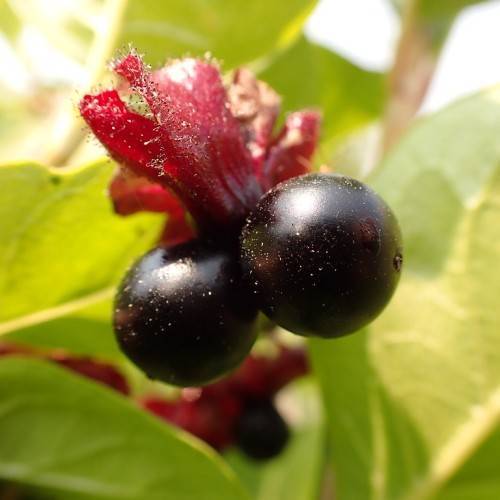
twinberry
Lonicera involucrata
Also Known As - bearberry honeysuckleCycle:
Perennial
Watering:
Frequent
Hardiness Zone:
4 - 10
Flowers:
Flowers
Sun:
Full sun Partial sun Shade
Soil:
Sandy Loamy Clay Humus Rocky
Fruits:
Fruits In Summer Ready In Fall
Edible:
Yes
Leaf:
Yes
Growth Rate:
High
Maintenance:
Low
Poisonous To Humans:
Yes
Poisonous To Pets:
Yes
Drought Tolerant:
Yes
Salt Tolerant:
Yes
Thorny:
Yes
Invasive:
Yes
Care Level:
Medium
watering
Twinberry (Lonicera involucrata) is a fast-growing, low-maintenance, evergreen shrub. It grows best in moist, well-drained soil and in an area that gets full sun or partial shade. Water twinberry regularly, especially during periods of drought, as it likes moist soil. During the summer, water deeply once per week or more if there has been no rain. Depending on the soil, it may need watering up to every 4 days during the hot summer months. In the winter, water only when the soil is dry to a depth of 2 inches. When twinberry is first planted, water it daily for the first 2 weeks and then adjust the watering schedule as needed. During periods of heat or drought, water it more often and in the colder months water less often. A layer of mulch will help keep the soil moist and reduce the need for frequent watering. Twinberry is a tolerant and resilient plant, making it an ideal choice for home gardens.
sunlight
Twinberry plants require full or partial sun to thrive and grow. The optimal amount of sunlight for this plant species is 6 to 8 hours of direct sunlight per day. During the summer months it is beneficial to receive more sunlight, as this ensures maximum photosynthesis. However, during the winter months the amount of direct sunlight should be reduced due to the shorter day lengths, as this will reduce the risk of the plant becoming stressed. When choosing a spot in the garden or even an indoor location for your twinberry, keep in mind that the plant prefers places that are shielded from strong winds and are well-drained.
pruning
Twinberry (Lonicera involucrata) can be pruned any time of year to keep it looking its best. The best time for severe pruning is in late winter or early spring to encourage new growth. Otherwise, light reshaping can be done any time within reason in the growing season. Some gardeners prune to maintain a specific size or shape, while others prune to encourage flowering. In either case, avoid pruning too much at once, as this can shock the plant and cause damage. If you are removing more than 1 third of the shrub's total growth, spread the pruning out over 2 or more years.
